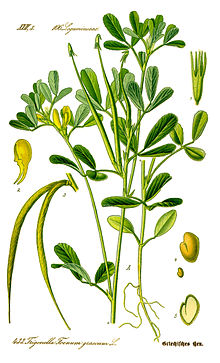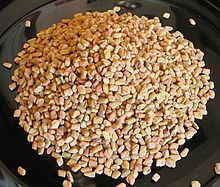- Fenugreek
-
Fenugreek 
Scientific classification Kingdom: Plantae (unranked): Angiosperms (unranked): Eudicots (unranked): Rosids Order: Fabales Family: Fabaceae Genus: Trigonella Species: T. foenum-graecum Binomial name Trigonella foenum-graecum
L.[1]Fenugreek (
 /ˈfɛnjʉɡriːk/; Trigonella foenum-graecum) is a plant in the family Fabaceae. Fenugreek is used both as a herb (the leaves) and as a spice (the seed, often called methi in Urdu/Hindi). The leaves and sprouts are also eaten as vegetables. The plant is cultivated worldwide as a semi-arid crop and is a common ingredient in many curries.
/ˈfɛnjʉɡriːk/; Trigonella foenum-graecum) is a plant in the family Fabaceae. Fenugreek is used both as a herb (the leaves) and as a spice (the seed, often called methi in Urdu/Hindi). The leaves and sprouts are also eaten as vegetables. The plant is cultivated worldwide as a semi-arid crop and is a common ingredient in many curries.Contents
History
The name fenugreek or foenum-graecum is from Latin for "Greek hay". The plant's similarity to wild clover has likely spawned its Swedish name: "bockhornsklöver" as well as the German: "Bockshornklee", both literally meaning: "ram's horn clover".
Zohary and Hopf note that it is not yet certain which wild strain of the genus Trigonella gave rise to the domesticated fenugreek but believe it was brought into cultivation in the Near East. Charred fenugreek seeds have been recovered from Tell Halal, Iraq, (radiocarbon dating to 4000 BCE) and Bronze Age levels of Lachish, as well as desiccated seeds from the tomb of Tutankhamen.[2] Cato the Elder lists fenugreek with clover and vetch as crops grown to feed cattle (De Agri Cultura, 27).
Production
Major fenugreek producing countries are Nepal, India, Pakistan, Bangladesh, Argentina, Egypt, France, Spain, Turkey, Morocco and China. India is the largest producer of fenugreek in the world where Rajasthan, Gujarat, Uttaranchal, Uttar Pradesh, Madhya Pradesh, Maharashtra, Haryana and Punjab are the major fenugreek producing states. Rajasthan produces the lion's share of India's production, accounting for over 80% of the nation's total fenugreek output. Qasuri Methi, more popular for its appetizing fragrance, comes from Qasur, Pakistan, and regions irrigated by the Sutlej River, in the Indian and Pakistani states of Punjab. (sources: T. Jilani PhD, Arizona, DASD 2007)[3][4]
Use
Cuisine
The cuboid yellow to amber coloured fenugreek seeds are frequently used in the preparation of pickles, curry powders, and pastes, and the spice is often encountered in the cuisine of the Indian subcontinent.[5] The dried leaves – also called kasuri methi (or kasoori methi in India and Pakistan), after the region of Kasur in Punjab, Pakistan province, where it grows abundantly – have a bitter taste and a characteristically strong smell. When harvested as microgreens, it also known as Samudra Methi, in Maharashtra, especially in and around Mumbai, Menthium or Venthayam in Tamil, where it is often grown near the sea in the sandy tracts, hence the name (Samudra means "ocean" in Sanskrit).[6]
Fenugreek is used in Eritrean and Ethiopian cuisine.[7] The word for fenugreek in Amharic is abesh (or abish), and the seed is used in Ethiopia as a natural herbal medicine in the treatment of diabetes.[7]
Some Jews customarily eat fenugreek during the meal of the first and/or second night of Rosh Hashana (The New Year).[8]
Lactation
Fenugreek seeds are thought to be a galactagogue that is often used to increase milk supply in lactating women.[9]
Medicinal
Arthritis has a low incidence rate in India where a lot of fenugreek is consumed. Drinking 1 cup of fenugreek tea per day, made from the leaves, is said to relieve the discomfort of arthritis.[10]
A June 2011 study at the Australian Centre for Integrative Clinical and Molecular Medicine found that men aged 25 to 52 who took a fenugreek extract twice daily for six weeks scored 25% higher on tests gauging libido levels than those who took a placebo.[11][12]
Seeds
Fenugreek seeds are a rich source of the polysaccharide galactomannan. They are also a source of saponins such as diosgenin, yamogenin, gitogenin, tigogenin, and neotigogens. Other bioactive constituents of fenugreek include mucilage, volatile oils, and alkaloids such as choline and trigonelline.
Fenugreek seeds are used as a medicinal in Traditional Chinese Medicine under the name Hu Lu Ba, where they are considered to warm and tonify kidneys, disperse cold and alleviate pain. Main indications are hernia, pain in the groin. They are used raw or toasted. In India about 2-3g of raw fenugreek seeds (called Methi in India) are swallowed raw early in the morning with warm water, before brushing the teeth and before drinking tea or coffee, where they are supposed to have a therapeutic and healing effect on joint pains, without any side effects.[citation needed]
Fenugreek is frequently used in the production of flavoring for artificial maple syrups. The taste of toasted fenugreek, like cumin, is additionally based on substituted pyrazines. By itself, fenugreek has a bitter taste.
Fenugreek seed is widely used as a galactagogue (milk producing agent) by nursing mothers to increase inadequate breast milk supply. Studies have shown that fenugreek is a potent stimulator of breast milk production and its use was associated with increases in milk production of as much as 900%.[citation needed][13](Dead link) It can be found in capsule form in many health food stores.[14]
Several human intervention trials demonstrated that the antidiabetic effects of fenugreek seeds ameliorate most metabolic symptoms associated with type-1 and type-2 diabetes in both humans and relevant animal models by reducing serum glucose and improving glucose tolerance.[15] Fenugreek is currently available commercially in encapsulated forms and is being prescribed as dietary supplements for the control of hypercholesterolemia and diabetes by practitioners of complementary and alternative medicine. Fenugreek contains high dietary fiber, so a few seeds taken with warm water before going to sleep helps avoiding constipation.[citation needed]
In Persian and Arabic traditional medicine, Fenugreek is known as حلبة (Helba or Hulba), tea made from the seeds is used to flush the kidneys and even fight kidney stones.
News
In February 2009, the International Frutarom Corporation factory in North Bergen, New Jersey, was found to be the source of a mysterious maple syrup aroma which had been reported as occasionally drifting over New York City since 2005. The odor was found to be an ester associated with fenugreek seed processing. No health risks have been found.[16]
Fenugreek seeds imported from Egypt in 2009 and 2010 have been linked to outbreaks of Escherichia coli O104:H4 in Germany and France, causing 50 deaths in 2011. [17][18]
References
- ^ "Trigonella foenum-graecum information from NPGS/GRIN". www.ars-grin.gov. http://www.ars-grin.gov/cgi-bin/npgs/html/taxon.pl?40421. Retrieved 2008-03-13.
- ^ Daniel Zohary and Maria Hopf, Domestication of plants in the Old World, third edition (Oxford: Oxford University Press, 2000), p. 122.
- ^ V. A. Parthasarathy, K. Kandinnan and V. Srinivasan, ed. Organic Spices. New India Publishing Agenies. pp. 694.
- ^ Statistics
- ^ http://www.bbc.co.uk/food/fenugreek
- ^ "How to Series: Growing Methi (Fenugreek)". A blog called "Fenugreek Love". http://fenugreeklove.wordpress.com/2009/11/16/growing-methi-fenugreek/. Retrieved 2 March 2011.
- ^ a b Gall, Alevtina; Zerihun Shenkute (November 3, 2009). "Ethiopian Traditional and Herbal Medications and their Interactions with Conventional Drugs". EthnoMed. University of Washington. http://ethnomed.org/clinical/pharmacy/ethiopian-herb-drug-interactions. Retrieved January 27, 2011.
- ^ This is based on the assumption that the Aramaic name רוביא corresponds to it. (Karetot 6a; Horiyot 12a) Rabbenu Nissim at the end of Rosh Hashana, citing the custom of R Hai Gaon. This follows Rashi's translation of רוביא, cited as authoritative by Tur and Shulchan Aruch OC 583:1. But Avudraham interprets רוביא as black-eyed peas.
- ^ Chantry, Caroline J.; Howard, Cynthia R.; Montgomery, Anne; Wight, Nancy (2004) (PDF). Use of galactogogues in initiating or augmenting maternal milk supply. ABM protocols, Protocol#9. The Academy Of Breastfeeding Medicine. Archived from the original on 2007-06-28. http://web.archive.org/web/20070628052457/http://www.bfmed.org/ace-files/protocol/prot9galactogoguesEnglish.pdf. "Supported in part by a grant from the Maternal and Child Health Bureau, Department of Health and Human Services."
- ^ Radio ABC Melbourne Victoria Australia Morning Programme 24 Mar 2011
- ^ John Thorpe (2011-06-20). "Get it to the Fenugreek? How Curry Can Seed Your Sex Life". San Francisco Chronicle. http://www.sfgate.com/cgi-bin/article.cgi?f=/g/a/2011/06/20/benzinga1183453.DTL.
- ^ Amanda Chan (2011-06-20). "Fenugreek: A Spice To Spice Things Up In The Bedroom". Huffington Post. http://www.huffingtonpost.com/2011/06/20/fenugreek-libido_n_880596.html.
- ^ http://www.breastfeeding.org/articles/fenugreek.html
- ^ http://www.breastfeeding.com/all_about/all_about_fenugreek.html
- ^ http://www.ncbi.nlm.nih.gov/pubmed/2194788 Effect of fenugreek seeds on blood glucose and serum lipids in type I diabetes
- ^ http://abclocal.go.com/wabc/story?section=news/local&id=6642803 abclocal.go.com
- ^ [1]
- ^ [2]
External links
- Gernot Katzer's spice dictionary – Fenugreek
- http://www.kellymom.com/herbal/milksupply/fenugreek.html
- Memorial Sloan-Kettering Cancer Center – About Herbs, Botanicals & Other Products
- Encyclopedia of Spices
Categories:- Faboideae
- Spices
- Leaf vegetables
- Edible legumes
- Indian ingredients
- Pakistani ingredients
- Plants used in Traditional Chinese medicine
- Medicinal plants
- Nitrogen-fixing crops
- Iraqi cuisine
Wikimedia Foundation. 2010.

